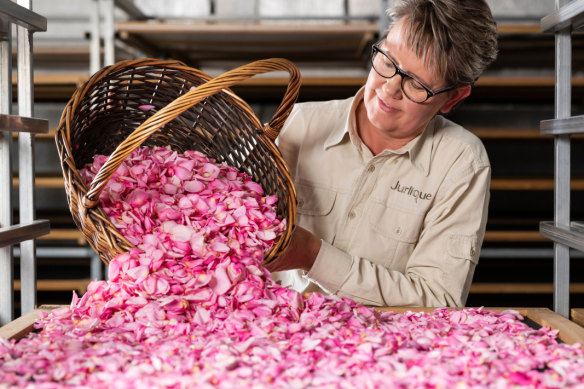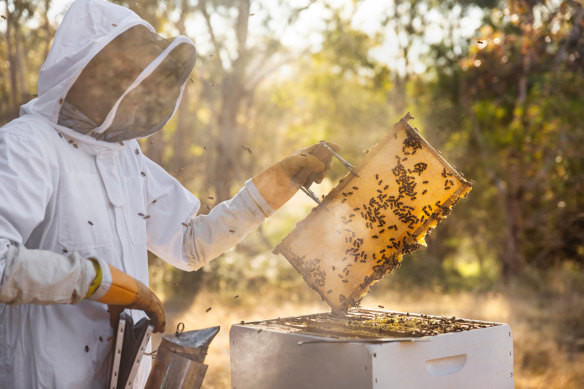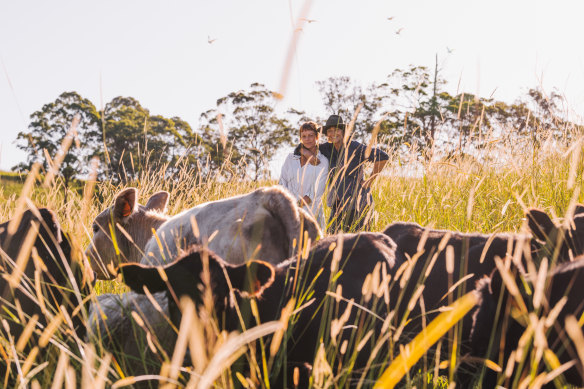Your favourite costly perfumes will make sense after a visit to this farm
By Lee Tulloch
It’s the pinkest rose I’ve ever seen, the colour of musk sticks, with a fragrance that’s just as sweet.
The only place it grows on Earth is over a few square hectares on Peramangk country in the Adelaide Hills. It’s not a native, but a rose specially cultivated for Australian skincare brand Jurlique.
I’m on a tour of the Jurlique farm with farm manager Cherie Hutchinson. It’s part of the company’s “seed to skin” approach to tourism, where visitors can take a leisurely, 90-minute walk through the organic and biodynamic farm, learning about the 40 different botanicals grown there and their use in skincare preparations, followed by a visit to the drying plant, where the flowers and herbs are laid out on racks as part of a three-step process of extracting the oils (the tour is $30 a person).

At the Jurlique flower farm in the Adelaide Hills, pink roses are harvested by hand and then dried.Credit: Jem Creswell/South Australia Tourism
It’s pleasant meandering through the gardens on a dry hot day, stopping to smell the various botanicals and discuss their health and skincare benefits. At each step we sample the serums, moisturisers and mists made from each plant. The backs of my hands are as soft as a proverbial baby’s when we finish the tour.
Years ago, I visited Grasse in France to learn about the roses that were grown especially for Chanel’s costly fragrances. The pretty pale pink May rose bloomed across several fields, ahead of being hand-picked for processing. Four hundred kilograms or 200,000 roses were needed to make just one kilogram of the concentrated Absolut that is the basis of the perfumes.
As with Jurlique, it isn’t difficult to appreciate why natural fragrances are so expensive. Hand-picking the delicate blooms and plants is labour-intensive and the natural processes take time.
The tour ends with a visit to the farm store for visitors to purchase a beauty product they’ve sampled in the garden. The brand is sold in 27 countries and a few Chinese tourists are exiting with a stash of skincare as I enter the shop.
It has a commercial side, but the tour is also a way for Jurlique to talk about the company’s 40-year-old commitment to biodynamic and regenerative agriculture, which uses crop rotation, moon rhythms, cosmic cycles and other natural practices.

Beekeeping supports pollination and promotes diversity on the farm.Credit: Jem Creswell/South Australia Tourism
The day I visit, the company has just been awarded the coveted B Corporation certification for high standards in social and environmental performance.
Back in the mid-1980s, when Jurlique launched, I visited the first flower farm and met with their inspirational founders, horticulturist Ulrike Klein and her husband Jurgen, a biochemist and naturopath.
I recall that they were acquiring an adjoining property that had been using chemicals on its crops and it was going to take many years to turn it organic so it could be certified. Now, the 155-acre farm is completely self-sustaining and flourishing, the result of the hard work of many horticulturists and farmworkers.
Although, or perhaps because, I’m someone who can kill a potted maidenhair fern with a glance, I’m interested in regenerative farming, which improves biodiversity, helps mitigate the effects of climate change and prevents land degradation and deforestation.
I was engrossed by Rachel Ward’s documentary Rachel’s Farm (streaming on Stan), which follows the actor and filmmaker’s unyielding efforts to turn the family’s hobby farm into a productive cattle business using regenerative practices. The physical effort and anguish involved in doing things such as building fences and improving the soil is edge-of-the-seat stuff, exhausting even to think about it.

Rachel Ward and her daughter Matilda Brown at the family farm in Macksville on the mid north NSW Coast. Credit: James Brickwood
Farm visits and immersive experiences in agriculture, such as grape picking, beekeeping and botanical propagation, are growing areas of tourism, if you’ll pardon the pun.
People recognise that they need to make a stronger connection between agriculture and what we put on our plates. It benefits children to see that food staples such as chicken and potatoes are not “born” in plastic bags on supermarket shelves or that blueberries don’t just magically appear in their breakfast pancakes.
Farmers who are moving into more sustainable practices are often eager to share their stories and keen to get the next generation involved. The quickest Google search will bring up dozens of farms using regenerative agricultural practices that are open to visitors, many supplying local markets.
When we know where something comes from, whether it’s skincare or steak, and what care and skill goes into producing it, it enhances our appreciation of it.
In the end, though, it’s just nice to spend a day smelling the roses.
The writer was a guest of the South Australian Tourism Commission.
Sign up for the Traveller Deals newsletter
Get exclusive travel deals delivered straight to your inbox. Sign up now.